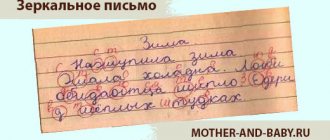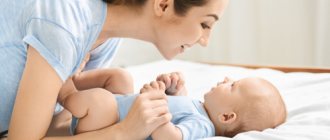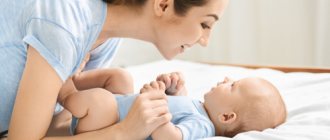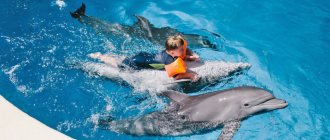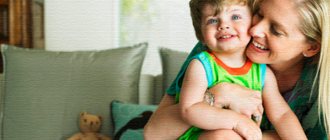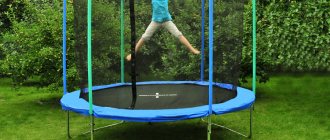If a child writes poorly - rearranges or skips letters, makes “stupid” mistakes in well-known words - primary school teachers usually advise “study more”, they say, over time quantity will turn into quality. But neuropsychologists believe that simple rewriting does little to develop the frontal lobes of the brain - this is precisely why writing suffers. And they offer their own tasks that will help you write correctly and accurately.
How are the brain and hand connected?
A third of the area of the motor cortex of the brain belongs to the projection of the hand, which, in turn, is located next to the speech zone. It is these two facts: the size of the projection of the hand and its close proximity to the speech zone that gave scientists reason to believe that the development of the hand leads to the formation and development of speech skills. But how will this fact help you write correctly?
To remember a vocabulary word, we pronounce it syllable by syllable and at the same time beat out the rhythm with the fingers of our right hand on the palm of our left hand. Thanks to the beatable rhythm, there is a feeling that the voice is sounding in the head, and perception, understanding, and memorization are enhanced.
Try pronouncing the word “ice cream” syllable by syllable:
ICE CREAM
Now speak, beating the rhythm. Do you feel the difference? Children are happy to use this technique to memorize and check the spelling of words.
This kind of inconsistency often occurs: the brain works faster than the hand, which leads to mistakes, unwritten words or rearrangements of letters and syllables. For this reason, the handwriting becomes illegible or, conversely, the writing is very slow, although accurate.
It's all about weak interhemispheric connections, low levels of self-control and arbitrariness of movements due to delayed development of the frontal lobes of the cerebral cortex. This feature can be corrected at home. To do this, you can perform the following tasks daily.
Psychological and neuropsychological assistance
Neuropsychology
is a field of medical psychology that studies the cerebral organization of a person’s mental activity during the period of his development - from the moment of birth and throughout the entire period of growing up - until a person reaches adulthood and the possibility of using this knowledge for
the diagnosis
and
rehabilitation
of human cognitive functions.
Neuropsychological diagnostics
is a non-hardware,
psychological research method
.
It is based on neuropsychological
tests (certain tasks and exercises) created by the founder
of neuropsychology,
the domestic scientist
A. R. Luria
, and adapted
by child psychologists
for childhood.
Neuropsychological diagnostics (neurodiagnostics)
allows us to differentiate
learning and behavioral difficulties
caused by insufficient development and (or) individual characteristics of the functioning of brain structures, from maladaptation associated with incorrect pedagogical influence or with pathocharacterological characteristics of the child’s personality, and also predict, even in the preschool period, to what extent individual characteristics of information processing will affect the development of mental functions and learning of a particular baby.
Based on a qualitative analysis of different types of errors made by a child when performing neuropsychological tests,
methods for their correction, it is possible to identify the entire range of possible disorders depending on the level of formation of the tested function, the zone of its proximal development, as well as the state of various links in the structure of a separate mental function and other functions with which it has common links.
Early neuropsychological diagnosis is very important
latent developmental deviations for the timely application of preventive treatment and
correction measures.
Which children especially need consultation with a neuropsychologist?
Children who have the following abnormalities:
- decreased overall performance
, - increased fatigue
, - absent-mindedness
, - disturbance of mental activity
, - deficiencies in speech development
, - decreased attention and memory function
, - unformed spatial representations
, - lack of self-regulation and control in the process of educational activities
, etc.
Neuropsychological diagnostics allows parents not only to understand the characteristics of the child’s development, but also to see his current and potential capabilities.
Neurodiagnostics includes research:
- motor functions of the child,
- interhemispheric asymmetry (assessment of right-handedness and left-handedness),
- speech functions,
- memory research,
- level of intelligence,
- reading and writing
- visual and visuospatial gnosis.
Exercises to develop interhemispheric interaction
- We write our name with one hand, and the word “well done” with the other.
- We draw a man with one hand - from circles, with the other - from rectangles.
- We color the picture with both hands. Moreover, we color the right part of the picture with the left hand, and the left part of the picture with the right.
- We trace the outline of the picture with both hands at once.
Useful tips
In order for the exercises to bring maximum benefit, you need to follow several rules:
- Don't expect results right away . You should start training by concentrating on one of the functions. You need to be patient, because the child may not succeed right away, he will be distracted. You shouldn’t pull the baby back, it will make it more difficult for him to concentrate. Only patience and effort will lead to a positive result.
- Do not overtire or overstimulate your baby . It is necessary to periodically switch the child’s attention, changing the types of games, but not do this too often. It is also important to maintain a daily routine, ensure proper sleep, and a calm environment.
- Install external frames . The child needs to be explained exactly what is possible and what is not. It is worth considering that a child cannot wait long, so rewards and punishments must be delivered on time. It could be a kind word, a small souvenir, but everything must be provided on time.
- It is better to start classes individually . When the child gets used to it a little, you can introduce him to group games. If you immediately start studying in a group, the child finds it difficult to concentrate; he looks at other children and copies their mistakes.
- While working, it is better to use several games at once : to develop attention, to relieve tension, to regulate the will, to consolidate results.
It is better to start a course of neuropsychological exercises with individual lessons with children.
Only by following all the rules, being patient and following the developed training program, you can achieve good results from the child.
Exercises to develop the frontal lobes of the cerebral cortex
- Please. We show various gestures, and the child must repeat them when he hears the magic word “please.” Gradually increase the pace of your gestures.
- It's the other way around. Let's clap our hands. When you clap 1 time, the child should clap 2 times. And vice versa: when you clap 2 times, he claps 1 time. Options: tapping your hand on the table or wooden spoons, stomping your foot, etc. Exercise improves the dynamics of mental processes, teaches you to quickly switch from one task to another.
- Arms, legs, head. We name the parts of the body, and the child must show them. But you need to be very careful, since you should show the part of the body that was named earlier. For example, you say “hands”, the child does not show anything. Then you say “head”, he shows his hands. You call “legs”, he touches the head.
- Rings. We connect the thumb of the left hand with the other fingers into rings one by one, starting with the index finger. We connect the thumb of the right hand with other fingers, starting with the little finger. Do it with both hands at the same time. We train concentration and switching of attention, as well as control and order of performing a series of movements.
- Games of our childhood. Games familiar to everyone from childhood will also help: “Edible - inedible”, “Sparrows - crows”, “Don’t say yes and no, don’t take black and white.”
- Gulliver and the Lilliputians. We invite the child to rewrite the words, starting with the largest or smallest letter, and then in descending or ascending order.
From the smallest letter to the largest.
From the largest letter to the smallest.
Indications for use
Neuropsychological exercises for children of primary and senior school age are a kind of test that will accurately determine and assess their health status.
During the assessment, the specialist asks the child to complete simple tasks, after which they can accurately tell about the child’s developmental characteristics and capabilities. It will be very useful to know the strengths and weaknesses of the baby in order to work with them correctly in the future.
Neuropsychology will also be effective if the child:
- there are problems with memory, performance and communication with peers;
- there is a delay in speech development, speech therapy disorders;
- there are disturbances in psychomotor development, sleep, and appetite;
- hyperactivity or vice versa inhibition;
- impulsiveness;
- problems with learning, he does not assimilate the proposed material well.
Neuropsychological exercises for children help improve the situation in the following cases:
- speech underdevelopment;
- DPR (delayed mental and psycho-speech development);
- ADHD (attention deficit hyperactivity disorder);
- autism;
- HIA (limited development opportunities);
- minimal brain function;
- underdevelopment of the brain body;
- mental and emotional disorders.
A specially selected complex will help the specialist to consistently activate each area of the brain separately. The program is developed individually, due to which it is possible to eliminate all violations thanks to tactile-kinesthetic exercises.
Fitball and balance boards
Westend61/Getty Images
There is a connection between the functioning of the vestibular system and speech skills, emotional stability and educational success. The cerebellum is responsible for the functioning of the vestibular apparatus, and it is stimulated by exercises on fitballs and balance boards. To integrate such exercises into regular classes, at the beginning of the lesson, replace the usual chair with a fitball for 5-7 minutes - this will arouse the child’s interest and help further concentrate on the need to hold the body. Do the same in the second half of the lesson if you notice the preschooler’s fatigue. Invite your child to bounce on a fitball and, with the help of an adult, perform various motor exercises on a large ball on the back and stomach.
When to expect an effect
Neuropsychological exercises for children will bring positive results after completing the first course. In total, you should take 2 courses consisting of 24 lessons. The duration of each lesson is half an hour.
Basically, classes are held in micro groups, which include 2 children, or with each child individually, 1 lesson 2 times a week for 3 months. The program is selected individually for each child in accordance with his characteristics and age.
It should be remembered that after the 6th lesson the condition may worsen, but after the 10th lesson improvements will be observed. After the first course, the child is prescribed a neuropsychological examination, and the question of when to take the course again, and whether it is needed at all, is decided.
Neuropsychological exercises will benefit the child if all the specialist’s recommendations are strictly followed.
Timely correction is important for children, thanks to which they not only do not lag behind in development, but they also retain the desire to learn and become more successful in life and school.
Main complex
At the beginning of the course, it is important to teach the child to develop proper breathing, which will optimize gas exchange and blood circulation. Proper massage of the organs located in the abdominal cavity will help speed up recovery, improve well-being, concentrate attention and relieve tension.
The basis is full breathing, which combines abdominal and thoracic breathing. It is performed in a lying position, then sitting and finally standing.
Four-phase breathing exercises are considered universal. Inhale - hold - exhale - hold: all stages should be equal in time for 2-3 seconds.
The table below presents a set of universal exercises:
| Body position | Execution Features |
| Lying on your back | Inhale, draw air slowly through the nose, at this time the anterior wall of the peritoneum should move forward. At this time, the diaphragm flattens, the volume of the lungs increases, and the chest expands. The air must be held for 3 seconds, and then exhaled slowly through the mouth, tightening the abdominal wall. Inhalation and exhalation should be smooth without jerking. |
| Lying on your back | Slowly raise one arm up, then a leg, and then two limbs at once while inhaling, hold in the raised position. As you exhale, return to the starting position. |
| Sitting on the floor | The back is straight, legs crossed, arms apart, hands clenched into fists, thumbs extended. When you inhale, raise your thumbs up, and when you exhale, lower them down. You can also stretch your arms forward and turn your thumbs left and right in time with your breathing. |
With ZPR
Children from 2 to 3 years old find it difficult to perform complex exercises. Therefore, several basic exercises have been developed for them . First of all, you should place a marker on the child’s left hand. For example, wear a bracelet or watch. In this way, the child will receive a basis for understanding his body. He will be able to easily remember that he is wearing a bracelet or watch on his left hand.
After this, you can give the child more extensive knowledge, for example the following:
- Exercise "Robot" . Many children enjoy playing this game. It’s like he becomes a robot himself and carries out the commands given to him. The specialist gives the command “left hand up, right hand forward, two steps forward, one step to the right, and so on.” All commands should be given gradually so that the child does not get confused or become nervous; it is very important that the child learns the success of following commands. It is better to perform such exercises in front of a mirror so that the child can observe how he performs the exercises and moves like a robot. After 2-3 lessons, the child will learn where left and right are and will follow all commands clearly. You need to do the exercises for no more than half an hour so that the child does not get tired and lose interest. After 3-4 sessions, you can add movements: perform them above your head, under your nose, behind your ear, in front of your eyes. Then add elements above and below. The movements can already be performed without a mirror, closing your eyes. When the robot has clearly completed the exercises, you can add another game.
- "Confusion" . You need to give commands, but do everything incorrectly, so that the child corrects the mistake himself and does everything as asked. Thus, it is good to concentrate the child's attention.
- "Photographer". An adult turns into a capricious photographer who can’t arrange his toys to take a photo. In this case, the child is involved in the game and asked to place the toys correctly: a bun to the right of the bear, an elephant to the left of the doll, and to build a pyramid of cubes behind the toys. Place a puzzle mat in front of the toys. After taking a photo, you can change the position of the toys. After looking at the photo on the computer, you can ask the child where which toy is located.
For children over 4 years old, you can use a more complex complex:
- “What first, what then?” . Children are asked questions: What season is over? What time is it now? What will happen next? What time of year does the year begin? After what season does spring come? You can lay out pictures in front of your child and invite him to put them in order - according to the seasons.
- “Find the same number . Numbers cut out of different materials are laid out in front of the child: wood, fabric and others. He needs to find the same numbers, for example, all 3.
- “Find out the number by touch . The cut out numbers are placed in a bag, the child puts his hand into it and looks for the suggested number, for example 1.
- "Make a figure" . The child is asked to put together a geometric figure from several parts: a square, a circle, a rectangle.
- "Big, small, medium" . Objects of different sizes are laid out in front of the child, and he is asked to arrange them into three piles according to size.
- “Collect a picture.” Any picture from a book or postcard is cut into 6-8 parts and the child is asked to assemble the picture.
For children 6-7 years old, it is better to choose exercises where he will need to learn how to design, cut, and make appliqués. He needs to go to school and he needs to be ready for it.
For ADHD
A way to completely cure ADHD has not yet been found, but special exercises will help the child manage his attention and control his actions. Each exercise is a game that should arouse interest and interest in the child.
No overload, otherwise the child will quickly get tired and lose interest in classes. It is better to combine the exercises; the session should last about 20 minutes.
Neuropsychological exercises are designed for a certain age. To maintain interest, children should definitely be encouraged by telling him after each exercise that he is “Well done,” “That he is the best.”
Here are a few games that help children 5-12 years old keep up with their peers in development:
- "Find the difference." The child must draw any object: a house or an animal. The drawing is passed on to an adult, who completes a few details. Then he gives the child the drawing, and he must indicate what has changed.
- "Tender paws ." An adult selects about 7 small objects that differ in texture. For example, it could be a piece of fur, a glass bottle, beads and others. The child is asked to bare his arm up to the elbow so that the supposed animal can walk on it with its gentle paws. With eyes closed, the child must guess the object by touch. Touching should be pleasant for the baby.
- "Brownian motion" . This is an exercise for a group of children. They are placed in a circle, and tennis balls are rolled inside one after another, which should not roll out of the circle. In this case, children can touch them with their feet or hands. The number of balls increases. The point of the game is to collect the maximum number of balls in a circle.
- "Pass the ball" . While sitting on chairs or standing in a circle, children must pass the ball to each other, while doing this as quickly as possible and without dropping it. You can make the task more difficult if you stand with your back to the middle of the circle and pass the ball behind your back.
All of these exercises for children with ADHD help them learn to plan, regulate and control their actions. In addition, they help improve concentration and properly distribute attention.
With disabilities
Neuropsychological exercises for children with disabilities help them move more. With this disease, the activity of biochemical processes is greatly reduced, the immune system weakens, the range of capabilities of the respiratory and cardiac systems is significantly narrowed, and the neuromuscular system weakens.
Special games will help improve physical and psychomotor qualities: develop accuracy and speed of movements, coordinate all movements, make joints more mobile, add strength to muscles, improve overall performance.
Before selecting a set of exercises and games, you need to determine which group your child belongs to. And there are three of them: sedentary, with medium mobility or high mobility.
For children with disabilities, you can choose the following set of exercises:
- "What's missing?" . Several objects are laid out in front of the child: a toy, a jump rope, a hoop and others. In a few minutes he needs to remember what was there, and then he closes his eyes and removes 1 item. He must open his eyes and say what is missing. You can complicate the exercise by adding objects or reducing the memorization time.
- “Repeat, don’t make a mistake.” A series of movements are smoothly performed in front of the child. He must then repeat everything exactly. Movements can be simple or complex.
- "Get to know a friend." The child is blindfolded and asked to find out who is standing in front of him by touch.
- "Zoo" . Children choose any animal for themselves and try to imitate its habits, while other children find out who lives in the zoo.
- "Find the letter" . Children are given letters. They must consult, form a word and stand in such a sequence that they can form the word.
There are a lot of exercises and games, children play with pleasure, especially in a group, competing with each other. After such games, the child learns to move faster, memory improves, and coordination of movements is honed.
